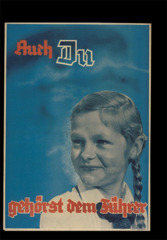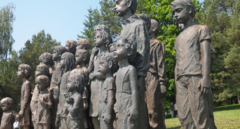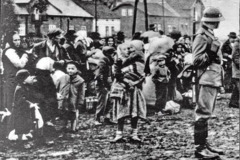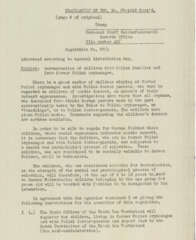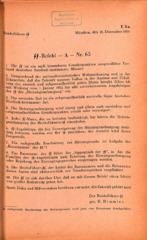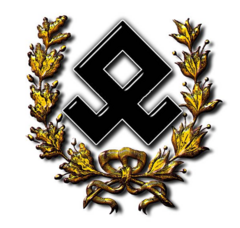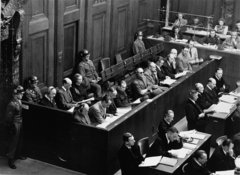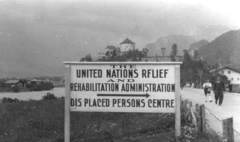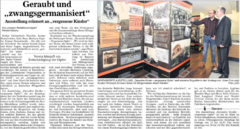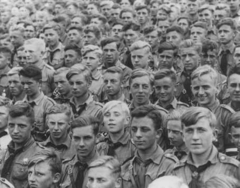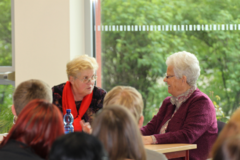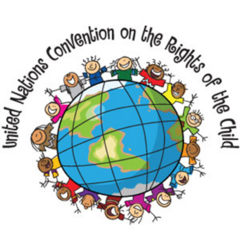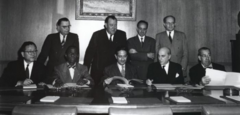Events & Organisations
Notable events and organisations related to WW II stolen children (hi)stories
-
The League of German Girls (BDM)
The League of German Girls (Bund Deutscher Mädel – BDM) was formed in 1930 as the female branch of the Hitler Youth movement; its role was to indoctrinate girls into the beliefs and ideals of the Nazi regime but also to prepare them for their most important role – to be future dutiful wives and mothers. The programme trained girls how to care for the home and family. They also learned useful skills such as sewing, nursing, cooking and household chores.
-
10 June 1942
The Lost Children of the Lidice Massacre
A small Czech town located 20km from Prague was annihilated on June 10, 1942, as an act of revenge for the assassination of Reich Protector Reinhard Heydrich. All the men from the village who were over 15 years of age were executed. Most women and girls 16 years of age and older were deported to Ravensbrück concentration camp. The village was set on fire and the remains of the buildings destroyed with explosives. All the animals in the village were slaughtered as well.
-
Children of Zamość
When the Germans decided to expand their living space to the East, their first step was “the Cleaning” (“Generalplan Ost”). The plan was to move the entire Polish population of the Zamość area to make room for German Volksdeutsche.
-
Regulation 67/1
In February 1942, SS Gruppenführer Ulrich Greifelt from Himmler’s office issued Regulation 67/1 for dealing with (Polish) children, which instructed RKFDV (The Reich Commissioner for the Consolidation of German Nationhood) and RuSHA (SS Race and Settlement Main Office) officials in the following terms:
-
Heiratsbefehl No. 65
SS Marriage Order (December 31, 1931)
-
The SS Race and Settlement Main Office
The RuSHA – Rasse- und Siedlungshauptamt “in charge of racial matters” was created in 1931 by two important SS officials – Heinrich Himmler and Richard Walther Darré. Initially, they were just overseeing the implementation of Himmler’s “1931 Marriage Order”, that is, they were responsible for issuing certificates of racial purity and marriage permits to members of the SS (only after a thorough investigation proved both prospective marriage partners to be of Aryan descent dating back to 1800).
-
Nuremberg, 20 October 1947 – 10 March 1948
RuSHA Trial
After World War II ended, many courts were established by the Allies to prosecute German officials. The famous Nuremberg Trials tried and convicted many of them in more than a dozen major proceedings.
-
The United Nations Relief and Rehabilitation Administration
UNRRA
The purpose of the UNRRA, an organization created in the White House on November 9, 1943, was to “plan, co-ordinate, administer or arrange for the administration of measures for the relief of victims of war in any area under the control of any of the United Nations through the provision of food, fuel, clothing, shelter and other basic necessities, medical and other essential services” (Agreement, Articles 1 and 2). Half of the organization’s budget came from the US government.
-
Geraubte Kinder – Vergessene Opfer e. V.
The organization “Stolen Children – Forgotten Victims” was founded with the purpose of cherishing the memory of tens of thousands of stolen children from Europe who were abducted by the German occupation authorities during the Nazi era and who were housed in institutions of the former SS organization “Lebensborn e. V.” and the German “home schools” where they underwent Germanization.
-
HJ – Hitlerjugend
The Hitler Youth
The Nazi Party’s goal was to exert influence over all aspects of German society, and youth – perceived as the foundation of the new world as future party members, mothers and soldiers – were seen as essential for the survival and the health of the People’s Community (“Volksgemeinschaft”).
-
Stolen children of the GDR
A rough estimate (because there are still no reliable statistics) is that somewhere between several hundred and as many as 2,000 East German children fell victim to politically motivated forced adoptions. In East Germany, the state expected parents to teach their children the principles of communism and loyalty to the regime. If the parents spoke against that regime or attempted to flee the country to the West – they were “unfit” to raise their children properly and the state “stepped in”.
-
Lebensspuren association
A small group of people, who were once children born on Nazi baby farms or kidnapped from their parents as toddlers because of their “Aryan” appearance, publicly met for the first time in 2006.
-
United Nations Convention on the Rights of the Child
In 1989, the leaders of 140 countries made a historic commitment to the world’s children by adopting this agreement. It has become the most widely ratified human rights treaty in history and has helped transform the lives of many children around the world.
-
The Convention on the Prevention and Punishment of the Crime of Genocide
The Genocide Convention was the first human rights treaty adopted by the General Assembly of the United Nations, on 9 December 1948, and signified the international community’s commitment to “never again” after the atrocities committed during the Second World War. Its adoption marked a crucial step towards the development of international human rights and international criminal law as we know it today.
